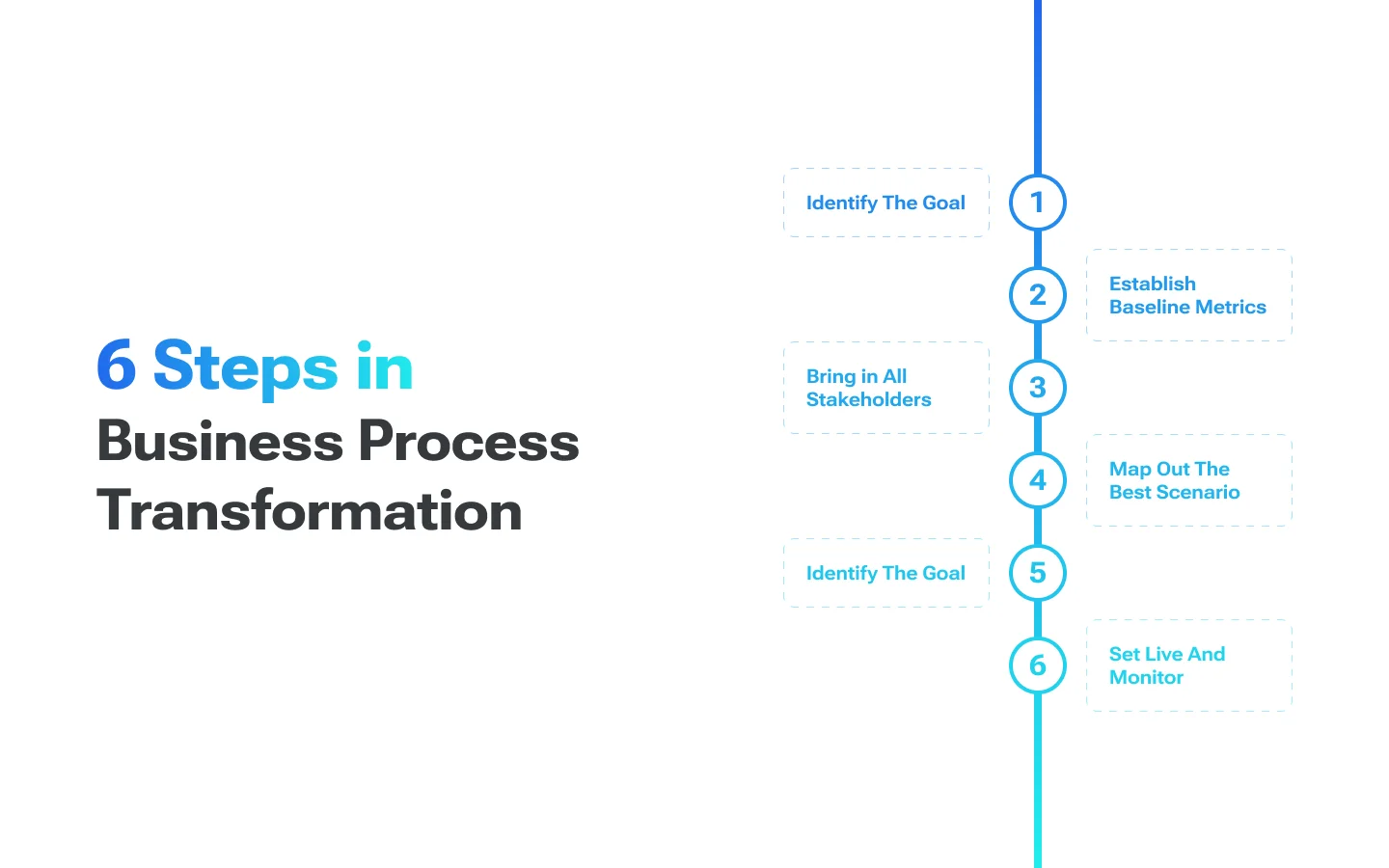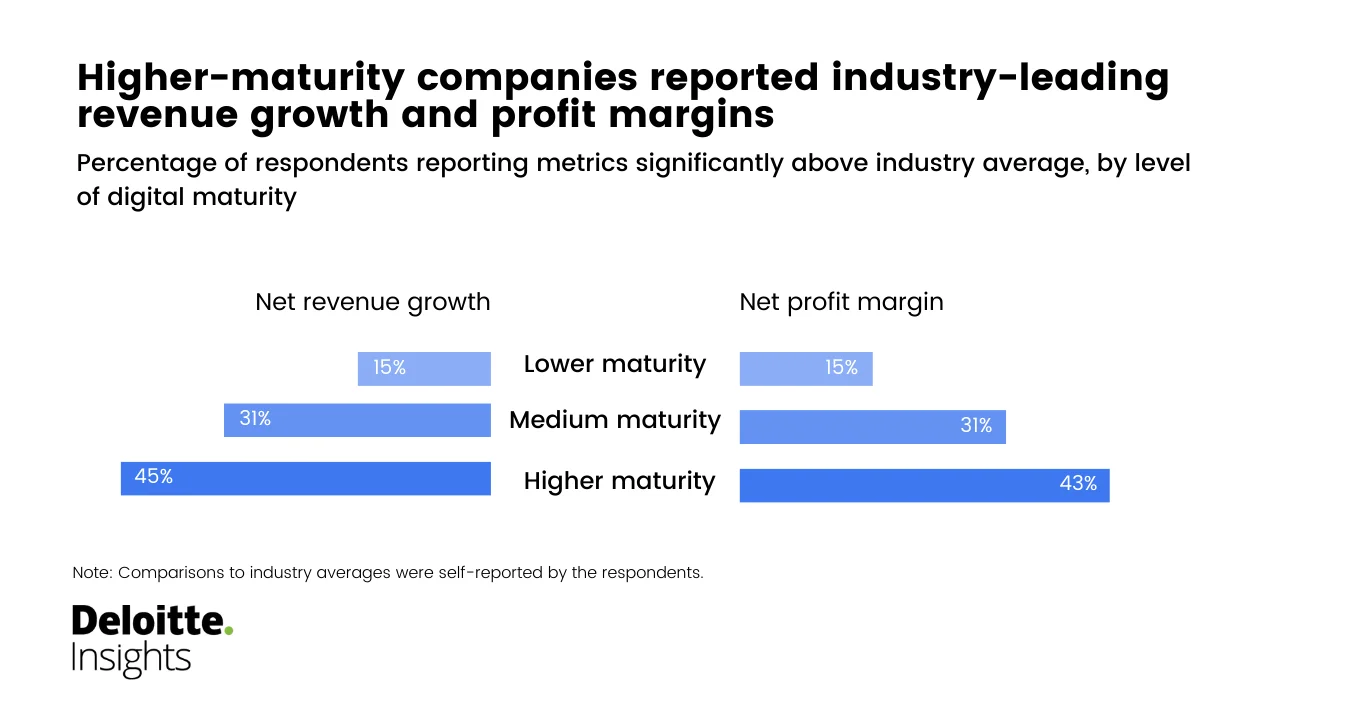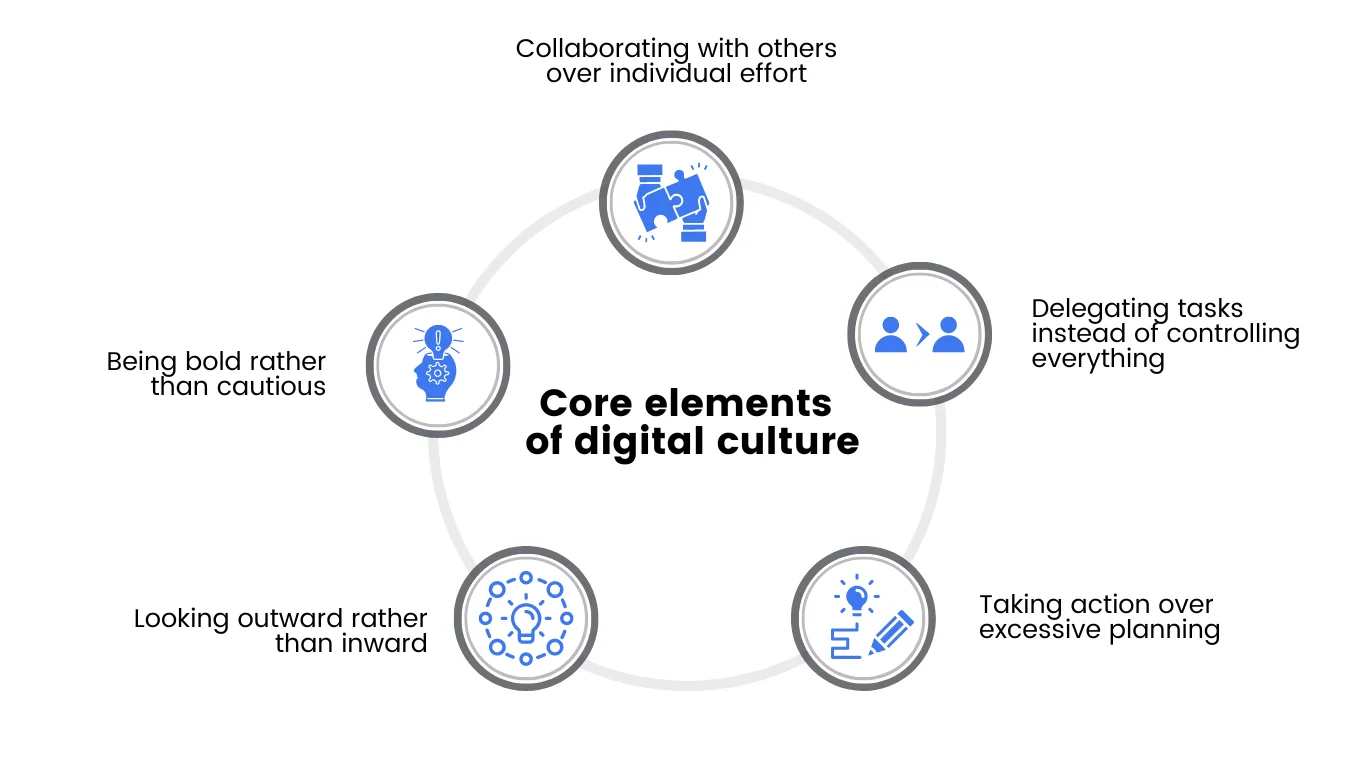This is a continuation of the series of articles about digital transformation. If the text seems unclear to you, start with the introductory article. In it, we discussed what digital transformation is. In this one, we will delve deeper into the topic and explore its four types.
In our journey through the digital terrain, understanding the distinct types of digital transformation models becomes the compass guiding businesses toward success. As technology reshapes industries, embracing these transformational paths is essential. A Deloitte study found that the higher the level of digital maturity, the higher the company's profits. Literally, the growth can reach up to 45%.
Four avenues stand out: Process Transformation optimizes operations, Business Model Transformation unveils new revenue streams, Domain Transformation reshapes industries, and Cultural Change drives innovation. Let’s sink into this topic to figure out how it can be adapted to your business.
What is the Digital Transformation Process?
Technology transformation is the holistic integration of digital technologies, processes, and cultural shifts to drive innovation, optimize operations, and unlock new value. A comprehensive survey by MIT Sloan Management Review in partnership with Deloitte reveals that 90% of executives consider digital transformation a top priority, highlighting its significance. However, not all transformations are equal, and aligning the right type with a company's unique requirements is paramount. Deloitte's research emphasizes that organizations achieving the most transformative impact tailor their approaches to their strategic objectives.
We all understand that digital transformation is not a commodity. It is the process that the C-level initially initiates. They indicate seismic transformations in how businesses design and use software, tweak internal procedures, and how people in these organizations think. But does it have to originate from within the company?
Remember when was the last time you used a handwritten note and a stamp to get across an important business message? Many things have gone digital. We become accustomed to connecting with the outside world through digital means. Our relationship with our end customers has changed, and so must we.
It’s important to mention that digitalization doesn’t mean transformation. Consider the following example: ten years ago your employees used office documents kept on their computers, but today we all use cloud-based services such as Google Docs. To share Word documents with colleagues, we might export them or send emails with the exported documents attached. We don't do that because the cloud enables speedier intra-team communication and collaborative editing without exporting — in real-time.
Seamless digital transformation with 30% faster time to market and budget savings of up to 20%
The premise is that digital transformation is more than just replacing old tools with new, digitalized ones. Instead, it requires a comprehensive shift in both technology and how people think about exploiting technology. As a result, digitalization may not always imply transformation.
What Are the Types of Digital Transformation?
| Type of transformation | The main purpose | Example | Benefits | Top niches to implement |
| Process Transformation | Optimizing workflows and operations using digital tools | A bank that automates its loan application process. Another more practical example is the McDonald’s mobile app. | Improved efficiency and cost savings. | Manufacturing, logistics, financial services. |
| Business Model Transformation | Rethinking the way a company creates, delivers, and captures value | Netflix's shift from DVD rentals to streaming. | New revenue streams, increased market reach, improved customer experience. | Retail, media, telecommunications. |
| Domain Transformation | Disrupting industries through digital innovation | A company that uses artificial intelligence to develop new drugs. Or Uber that changed the transportation industry. | Increased innovation, faster time to market, and new competitive advantages. | Transportation, hospitality. |
| Cultural/Organizational Transformation | Shifting mindset and behavior to embrace digital culture | Ukrainian or Estonian Government. Diia — the state in the smartphone. | Increased agility, improved decision-making, enhanced employee engagement. | Any industry. |
Process Transformation. This type centers on refining existing workflows and processes using digital technologies. An example is McDonald's mobile app (Burger King’s app, KFC’s app, etc.), which streamlines ordering, payment, and pickup processes. The benefits encompass heightened efficiency and cost savings. Manufacturing and logistics sectors reap substantial rewards from this transformation, as automation enhances production speed and accuracy. To succeed, companies must prioritize employee training and change management to ensure smooth adoption.

Business Model Transformation. Here, organizations reimagine how they generate revenue and deliver value. Netflix's transition from DVD rentals to streaming epitomizes this type. The advantages lie in new revenue streams and strengthened market positioning. Another example is the Ukrainian retailer “Techno Yozh” which initially was an offline store network (so-called mini islands in big malls). But in two years expanded into two global markets – Chinese and Asian – as an online store. Industries like entertainment and subscription services could do with such a transformation, but understanding customer preferences is paramount for success. Also, the company must have strong leadership and commitment from top management to hit the ground running.
Digital transformation vs business transformation
Domain Transformation. This type disrupts industries through innovative digital strategies. Uber's reinvention of the transportation industry is a testament to this. The case of Amazon, which moved into a new market domain with the launch of Amazon Web Services (AWS), is another outstanding example of how domain transition occurs. AWS is currently the world's largest cloud infrastructure service provider, having surpassed high-profile titans Microsoft and IBM. Businesses gain market leadership and expansion potential. Transportation and hospitality sectors stand to gain, although navigating regulatory compliance and building industry partnerships are pivotal for sustainable success. But there are also several things to take into account. For example, careful selection of the right technologies and regulatory compliance, as well as industry partnerships.
Cultural Transformation. Shifting corporate culture to embrace digital innovations is the essence of this transformation. Netflix is an example of such a pivotal change in corporate culture. Did you know that Netflix's HRD advised her subordinates to go on job interviews at other tech giants? In her opinion, this has a positive effect on employees' awareness of their professional worth. Enhanced innovation and adaptability are the rewards, applicable across all industries. Leadership commitment and transparent communication are vital when embarking on this transformational journey.
Choosing the Right Digital Transformation Type
In the labyrinth of digital transformation examples and possibilities, selecting the optimal path requires carefully analyzing various factors. These factors go beyond industry trends and delve into the heart of the business itself.
Assessing Business Objectives and Challenges. The starting point is a crystal-clear understanding of the company's objectives and pain points. Are efficiency gains the priority, or is it entering new markets? A study by Accenture reveals that 73% of companies that align their digital transformation strategies with business goals see a significant impact on their performance.
Conducting a Comprehensive Digital Readiness Assessment. Evaluating the organization's current digital capabilities is essential. This evaluation spans technology infrastructure, skill gaps, and cultural receptiveness. According to a survey by PwC, 54% of digital transformations fail due to a lack of clear strategy and low organizational readiness. That’s why in 2023, tech startups like Digital Knights or DevAssist that help to find elite pre-vetted developers are springing up.
Identifying the Areas with the Highest Potential for Impact. Focusing on areas with the most potential for transformational impact is crucial. A McKinsey study found that organizations prioritizing customer experience transformation achieve a 20-30% increase in customer satisfaction and economic gains.
Balancing Short-term Gains with Long-term Vision. While quick wins can build momentum, they should align with the long-term vision. Covid-19, the war in Ukraine, and the recession in the US have taught us not to plan too far ahead. However, there should definitely be a vision; otherwise, it simply becomes uninteresting to do business. IBM's survey indicates that balancing immediate benefits and long-term goals is pivotal for digital transformation success. Btw, the time it takes to close a skills gap through traditional training has increased by more than ten times in the past four years, jumping from 3 days to 36 days. That emphasizes one more time the importance of balancing between long-term vision and chasing rapid results.
The Steps of the Digital Transformation Process
Embarking on the digital transformation journey is akin to charting new territories; a carefully planned expedition is paramount. The process encompasses several crucial steps that guide organizations from envisioning the transformation to realizing its full potential.
1. Define Clear Goals and Objectives. Begin with articulating clear business long-term goals and short-term objectives aligned with digital transformation. Domino's Pizza provides a compelling example; their objective was to enhance customer experience through digital channels, resulting in a 23% increase in same-store sales.
2. Assess Current State. A comprehensive assessment of the organization's existing digital capabilities and infrastructure is key. Understanding gaps and strengths informs the transformation strategy. This approach aided Royal Dutch Shell by leveraging IoT sensors to monitor equipment, leading to a 5% reduction in operating costs.
3. Design Transformation Strategy. Tailor the strategy to address identified gaps and leverage opportunities. This stage requires envisioning the desired future state and delineating the roadmap. This could involve investing in new technologies in the future or retraining employees to better utilize existing tools. Additionally, it's important to take into account an understanding of your target audience and their needs, as well as the broader trends and challenges within your industry.
4. Secure Leadership Commitment. Leadership alignment is vital for transformation success. CEOs need to champion the initiative, fostering a culture of adaptability and innovation. As noted by Satya Nadella, CEO of Microsoft, "Culture is the heart of digital transformation."
5. Foster Cross-functional Collaboration. Collaboration across departments is crucial to ensure smooth integration and execution. Amazon's (as well as other tech companies') agile approach, where cross-functional teams work together, contributed to the launch of Amazon Web Services (AWS), generating billions in revenue.
6. Implement and Monitor. Execute the strategy in phases, with continuous monitoring and adjustments. Burberry's digital transformation involved integrating technology into retail spaces, enhancing customer engagement, and boosting sales to £7.6M.
7. Embrace Change Management. Address the human element of transformation through effective communication, training, and change management. An excellent example of change management is the Ukrainian state application Diia (the one that stores digitized documents of Ukrainians). During the war, the risk of user data leaks increased. Therefore, the government closed registries and access to digital passports, creating a so-called e-Document instead. It replaced passports until data protection was strengthened.
To sum it up
As far as you know what is digital transformation, it’d be much easier for you to embrace its four types. Process Transformation optimizes operations, Business Model Transformation uncovers new value streams, Domain Transformation reshapes industries, and Cultural Change fosters innovation. But the salt is in digital transformation examples: Shell, AWS, Burberry, and of course, Ukrainian Diia — they all showed how profitable technology transformation could be.
In the face of fast-paced technological shifts, embracing digital transformation isn't just a strategy; it's an ongoing commitment to innovation and resilience. The digital journey necessitates continuous learning, adaptability, and a keen eye for emerging trends.
Is your legacy infrastructure holding back your company's growth and innovation?






